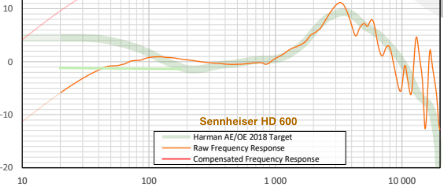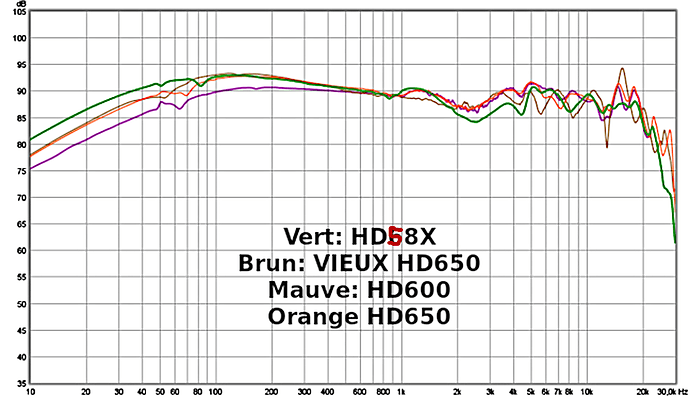tl;dr: To answer the tuning or frequency response portion of your question, Dober, according to some well-regarded measurements the HD 58X has the upside of less sub-bass roll-off than any of the 600 series. But the trade-off is that it is somewhat recessed in the upper mids.
Long-winded: To extend on LeDechaine’s response, here is another set of data points toward understanding where the HD 58X fits in. Again, these measurements are all from the same (reliable) source called Oratory 1990 (https://www.reddit.com/r/oratory1990/wiki/index), but this time these are raw, un-massaged data*:




Explanation for those not familiar with reading FR graphs:
General
The orange line is the frequency response. (Sound is pulses of air pressure change. The faster these changes arrive at the ear the higher pitched they will sound. Frequency = pitch. Lion’s growl = low or deep or bass in pitch. Bird’s chirp = high or treble in pitch. Human voice in the middle. See the graphic I appended to the end of this post**.)
The broad green line is a bass-lover’s version of a flat or reference frequency response. So I added an alternate thinner green line to each graph to indicate an un-boosted or flat bass response.
The left/right axis covers the human audible spectrum of frequencies/pitches from deepest bass on the far right to shrillest treble on the far left.
The up/down axis goes from quiet to loud in units called decibels or dB. Wherever the orange line rises above the green line any sound in that region of frequencies will be louder than they should be. How far above the green line the orange line is indicates how much louder that region of frequencies will be. Conversely, wherever the orange line falls below the green line sounds in that region will be quieter than they should be. The 1 dB loudness change from one horizontal line to the next is just barely perceptible.
(Note: looking at just the wide green line, the elevation on the left is just the personal preference of bass-lovers. But the at-first gentle then rapid rise from the middle of the graph to the right is the very real loudness boost that comes from the particular shape of the human ear. Our brains take that ear boost for granted and edit it out of our perception. But headphones have to reproduce it or the brain will make us perceive a relative loss of loudness.)
Particulars
The first thing all four of these graphs have in common is that the deepest bass (below 60 Hz) is progressively quieter than it ideally should be. Few acoustic instruments and no human voices extend in this region. But certain genres have lots of action down there. If it’s important to what you listen to, you’re likely to already know that.
The next thing we might notice is that they all have a slight loudness boost in the 100 to 300 Hz region, roughly the upper bass and lower mids. This is a combination of what recording engineers call the warmth and mud frequency regions. Elevation here causes instruments and voices to sound too thick. (But this issue is small for these headphones and will rarely be noticed.)
Next, the middle mids, roughly from 300 to 1000 Hz, the heart of the human vocal range looks to be excellently on target in all but the HD 58X. But much of the 58X discrepancy is actually due to the green line being placed too low on that graph. Once we mentally drop the green line by 1 dB to get a valid comparison with the other graphs the issue pretty much goes away.
Next, the upper mids, roughly from 1000 to 3000 Hz, are recessed or quieter for the HD 660 S and the HD 58X than is ideal but the others are near-perfect. These frequencies are the highest two octaves on a piano and are higher than all but the shrillest female voice ranges.
Finally, the far right of the graphs are the treble frequencies. These mainly cover the overtones produced by voices and instruments in addition to their fundamental frequencies. Loudness above the green line in this region can be irritating to painful where that excess of loudness coincides with a person’s treble sensitivities.
Three of these four headphones err very much on the side of too quiet, rather than the too loud side in the treble region. The HD 600 has two tall spikes at the far right. Keep in mind that few people past their teens will be able to even hear that final spike. Never heard anyone report being bothered by the second-to-last spike. There is also likely to be great variance from unit to unit of a particular model of headphone in this region.
The only other headphones I’ve seen graphs for that rival these Sennheisers for neutrality are the more expensive open-back Focals. Neutrality/flatness can be a good thing if you listen to a broad range of music genres or if you listen to purely acoustic music like folk, jazz or (god forbid) classical. In general, the value of neutrality is more in doing no harm rather than in doing good. Any non-neutrality may have enjoyable consequences for one genre yet have equally irritating consequences for another.
Footnotes
*LeDechaine’s graph presents measurements from the DIY Audio Heaven site (https://diyaudioheaven.wordpress.com/). The frequency curves of the DIY graphs are compensated. That means they show how the raw data varies from some equivalent of the broad green reference line seen in the Oratory graphs I show.
Since I can’t find the reference line being used anywhere on the DIY site, I don’t know exactly how to interpret the DIY graphs. Does the DIY reference line include a bass boost like the Oratory green line does? How high is the treble peak in the DIY reference? Dunno. But as long as you’re strictly comparing one DIY graph to another, as Le Dechaine does, there’s still a lot to be learned from them.
**Frequency/pitch visual:


 Even in comparisons I found against other current headphones like an AKG712 or Fidelio X2.
Even in comparisons I found against other current headphones like an AKG712 or Fidelio X2.



